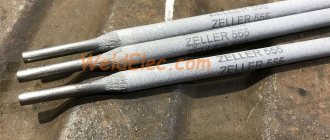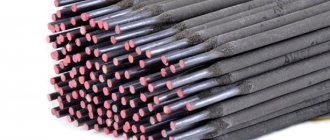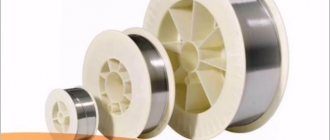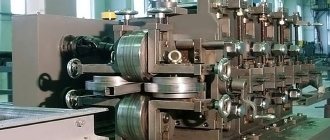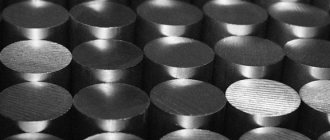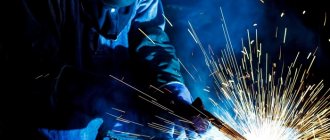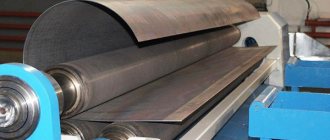The melting point of steel type 18-8 is 1475°C
| steel grade | Weldability | Technological features of welding | ||
| Medium alloyed | 12X5; X5; Х5М;Х5ВФ | GOOD | Shielding gas: CO2, Ar Electrode wire: Sv-08KhG2SM; Sv-04Х19Н9; Sv-06Х19Н9Т | Cleaning edges to a metallic shine |
| 20ХГС 25ХГС 30ХГС 30ХГСА | SATISFACTORY | Shielding gas: CO2; CO2+O2; Ar+СО2 Electrode wire: Sv-10GSM; Sv-10GSMT; Sv-10HG2S; Sv-15KhMA; Sv-18KhGSA With a thickness of up to 10 mm - without heating More than 10 mm - preheating to 250-300°C | ||
| 15ХМА 20ХМА | Shielding gas: CO2; Ar; Ar+СО2 Electrode wire: Sv-08ХГСМА; Sv-08ХГ2СМА Preheating to 250-300°C followed by high tempering | |||
| High alloy | 0X13 1X13 2X13 | Shielding gas: Ar; CO2; Ar+СО2 Electrode wire Sv-10Х13; Cv-06X14; Sv-08Kh14GT with subsequent tempering to 700°C | ||
| Х17Н2 1Х17Н2Т | Shielding gas: Ar; CO2 Electrode wire: Sv-10X13; Sv-06X14; Sv-08Х18Н2ГТ Temperature up to 700°С | |||
| Х18Н10Т 0Х18Н12Б X18H12M2T | GOOD | Shielding gas: Ar; CO2; Ar+CO2; Ar+O2; Ar+СО2+О2 Electrode wire: Sv-06Х19Н9Т; Sv-08Х20Н9Г7Т | ||
| Х18Н9 Х17Н5Г9 Х17Н4Г9 | Shielding gas CO2 Electrode wire: Sv-08Х20Н9С2БТУ; Sv-07Х18Н9ТУ | |||
Welding low alloy steels. How to weld low alloy steel
Welding of low-alloy steels has found wide application in the manufacture of structures in construction.
This is due to the fact that low-alloy structural steels have increased strength and, due to this, metal structures are lightweight and, therefore, more economical. As a rule, the weldability of low-alloy structural steels is satisfactory. But, it is necessary to take into account that when the carbon content in the steel composition is more than 0.25%, there is a risk of the formation and development of hardening structures and hot cracks in the weld. In addition, other weld defects, such as the formation of pores, are likely to occur. And this happens due to carbon burnout during welding.
Steel 30ХМ (30ХМА) structural alloy
Decoding
- According to GOST 4543-2016, the number 30 in the designation of steel indicates the average mass fraction of carbon in steel in hundredths of a percent, i.e. carbon in steel 30ХМ is about 0.30%
- The letter X indicates that the steel contains chromium (Cr), the absence of numbers behind the letter indicates that the steel contains up to approximately 1.5% chromium.
- The letter M indicates that the steel contains molybdenum (Mo), the absence of numbers behind the letter indicates that the steel contains up to 1.5% molybdenum.
- The presence of the letter A at the end of the steel grade designation indicates that 30ХМА steel is high-quality, i.e. with increased requirements for the chemical composition and macrostructure of metal products made from it compared to high-quality steel.
Substitute
| Replaceable steel grade | Steel substitutes | |||
| 30ХМ (30ХМА) | 35ХМ | 35HPA | ||
Foreign analogues [1, 2]
| Designation of steel grade, (country) | Standard | Other name |
| 15 131 (Czech Republic/Slovakia) | CSN 415131 | |
| 2225 (Sweden) | SS | OVAKO 522 (S-6) |
| 4130 (US) | SAEI404, AISI | G 41300, 6348 A (AMS) |
| 1717 CDS 110 UK | B.S. | |
| 4130 (Australia) | AS 1444 (86) | |
| 25 CD 4 (France) | AFNOR.NF A-35-556 (84) | F 66S (F-05) |
| 30CrMo4 (Italy) | UNI 6403 (86) | D 221 (1-04), UM6 (1-07) |
| 25CrMo4 (Germany) | EN10083-1, DIN 1652 T.4, DIN 1654 T.4, DIN 17176, DIN 17204, E17201 | 1.7218 |
| 30ChM (Bulgaria) | BDS 6550 | |
| 25CrMo4 (Spain) | UNE 36 051-91 (1) | |
| 25CrMo4 (European standards) | EN 10083-1 (91) | |
| 30CrMo (China) | GB3077-88 | |
| S4730 (Yugoslavia) | JUS C.B9.021 | |
| F.222 (Spain) | — | A-222 (E-2) |
| SCM 430 (Japan) | JIS | |
| SCM2 (Japan) | JIS G4105 (74) | |
| 30HN (Poland) | PN/H 84030/04 |
Chemical composition, % (GOST 4543-2016)
| steel grade | Mass fraction of elements, % | |||||||||
| WITH | Si | Mn | Cr | Ni | Mo | Al | Ti | V | B | |
| 30ХМ | 0,26-0,34 | 0,17-0,37 | 0,40-0,70 | 0,80-1,10 | — | 0,15-0,25 | — | — | — | — |
| 30ХМА | 0,26-0,33 | 0,17-0,37 | 0,40-0,70 | 0,80-1,10 | — | 0,15-0,25 | — | — | — | — |
Type of delivery
- Long products, including shaped steel: GOST 4543-71, GOST 2590-88, GOST 2591-88, GOST 2879-88.
- Calibrated rod GOST 7417-75, GOST 8559-75, GOST 8560-78, GOST 1051-73.
- Polished rod and silver GOST 14955-77.
- Strip GOST 103-76.
- Forgings and forged blanks GOST 1133-71, GOST 8479-70.
- Pipe GOST 8731-74, GOST 8732-78.
Characteristics and properties [3]
Chrome-molybdenum steel 30ХМ (30ХМА) is a structural alloy steel that can be improved. The usual heat treatment of such steels is oil quenching and high tempering (550-650°C).
The hardenability of 30ХМ is slightly higher than that of 40Х steel, but the cold brittleness threshold is lower; in addition, 30ХМ steel is insensitive (like other molybdenum steels) to type II temper brittleness.
Purpose
- shafts,
- gears,
- spindles,
- hairpins,
- flanges,
- disks,
- tires
- rods and other critical parts operating under conditions of heavy loads and speeds at temperatures up to 450-500 °C.
- Jet engine power parts operating at temperatures up to 450°C.
The use of 30KhMA steel as a pipeline material depending on the parameters of the transported medium (GOST 32569-2013)
| Technical requirements for pipes (standard or specifications) | Nominal diameter, mm | Types of tests and requirements (standard or specifications) | Transported medium | Pipeline design parameters | ||||
| Maximum pressure, MPa | Maximum temperature, °C | Pipe wall thickness, mm | Minimum temperature depending on the pipe wall thickness with stress in the wall from internal pressure [σ], °C | |||||
| more than 0.35[σ] | no more than 0.35[σ] | |||||||
| TU 14-3-433-78 TU 14-3-251-74 | 6-500 | TU 14-3-433-78 TU 14-3-251-74 | All environments (see tables 5.1 (GOST 32569-2013)) | ≤80 | 450 | — | minus 30 | minus 50 |
The use of steel 30ХМ and 30ХМА as a material for the manufacture of fasteners (GOST 32569-2013)
| steel grade | Technical requirements | Acceptable operating parameters | Purpose | |
| Wall temperature, °C | Medium pressure, MPa (kgf/cm2), no more | |||
| 30ХМ, 30ХМА GOST 4543 | STP 26.260.2043 | -40 to +450 | 16(160) | Studs, bolts |
| -40 to +510 | Nuts | |||
| -70 to +450 | Washers | |||
Limits of application, types of mandatory testing and control of steel 30ХМА for flanges, lenses, gaskets and fasteners for pressures above 10 MPa (100 kgf/cm2) (GOST 32569-2013)
| Steel grade, standard or specification | 30ХМА | ||||
| GOST | 10494 | 10495 | 9399 | 10493 | |
| the name of detail | Hairpins | Nuts | Flanges | Lenses | |
| Limit parameters | Wall temperature, °C, no more | -50 to +400 | -50 to +510 | -50 to +400 | |
| Nominal pressure, MPa (kgf/cm2) no more | 80 (800) | 100 (1000) | 80 (800) | ||
| Mandatory tests | σ0.2 | + | + | + | + |
| σв | + | + | + | + | |
| σ | + | + | + | + | |
| f | + | — | + | — | |
| KCU | + | + | + | + | |
| HB | + | + | + | + | |
| Control | Flaw detection | + | — | + | + |
| Non-metallic inclusions | — | — | — | + | |
Maximum permissible temperature for the use of 30KhMA steel in hydrogen-containing environments, °C (GOST 32569-2013)
| Temperature, °C, at partial pressure of hydrogen, MPa (kgf/cm2) | ||||||
| 1,5 (15) | 2,5 (25) | 5 (50) | 10 (100) | 20 (200) | 30 (300) | 40 (400) |
| 400 | 390 | 370 | 330 | 290 | 260 | 250 |
Maximum permissible temperatures for the use of 30KhMA steel in environments containing ammonia, °C (GOST 32569-2013)
| Temperature, °C at ammonia partial pressure, MPa (kgf/cm2) | ||
| From 1 (10) to 2 (20) | From 2 (20) to 5 (50) | From 5 (50) to 8 (80) |
| 340 | 330 | 310 |
Conditions for using 30ХМА steel for bodies, covers, flanges, membranes and valve assembly made from rolled products, forgings (stampings) (GOST 33260-2015)
| ND for supply | Temperature of the working medium (wall), °C | Additional instructions for use |
| Long products GOST 4543. Forgings GOST 8479 | -50 to 450 | For non-welded fittings with mandatory heat treatment (hardening and high tempering) at a temperature of the working medium (wall) below minus 40°C to minus 50°C |
Conditions for using 30KhMA steel for reinforcement fasteners (GOST 33260-2015)
| Material grade, class or group according to GOST 1759.0 | Material standard or specification | Application options | |||||
| Bolts, studs, screws | Nuts | Flat washers | |||||
| Ambient temperature, °C | Nominal pressure PN, MPa (kgf/cm2) | Ambient temperature, °C | Nominal pressure, MPa (kgf/cm2) | Ambient temperature, °C | Nominal pressure, MPa (kgf/cm2) | ||
| 30ХМА | GOST 4543 | -40 to 450 | Not regulated | -40 to 510 | Not regulated | -70 to 450 | Not regulated |
NOTE. It is allowed to use fasteners made of steel grade 30ХМА at temperatures below minus 40°C to minus 60°C, if during impact bending tests on samples of type 11 according to GOST 9454 at operating temperatures below zero, the impact strength is not lower than 300 kJ/m2 (3 kgf* m/cm2) on any of the tested samples.
Recommendations for the use of steel 30ХМА for parts of valves and pneumatic actuators that do not operate under pressure and are not subject to welding, intended for operation at low temperatures (GOST 33260-2015)
| Quenching + tempering at temperature, °C | Approximate strength level, N/mm2 (kgf/mm2) | Application temperature not lower, °C | Use in thickness no more than, mm |
| 550 | 950 (95) | -80 | 30 |
Resistance of steel 30ХМА against crevice erosion (GOST 33260-2015)
| Durability group | Point | Erosion resistance against steel 12X18H10T | Material |
| Reduced durability | 4 | 0,15-0,25 | Forged alloy pearlitic steel 30ХМА, containing up to 1.5% chromium, heat treated at KP50 - KP75 and its welded joints |
NOTE. The coefficient of erosion resistance of a material is the ratio of the rate of erosive wear of the material to the rate of erosive wear of steel 12Х18Н10Т (taken as 1).
Recommended heat treatment of steel 30ХМА [4]
- Preliminary heat treatment: normalization at 900°C, tempering at 670°C.
- Final heat treatment: hardening at 880±10°C in oil, tempering at 550-650°C with cooling in oil or water.
Approximate heat treatment regimes for 30ХМ steel [5]
| steel grade | Heat treatment operation | Temperature, °C | Cooling method | Hardness HB |
| 30ХМ | Normalization | 840-860 | On air | 207-255 |
| Annealing | 830-850 | Slow | 187-229 |
Heat treatment modes for steel 30ХМ and 30ХМА [5]
| steel grade | Heat treatment | |||
| Hardening | Vacation | |||
| Temperature, °C | Cooling medium | Temperature, °C | Cooling medium | |
| 30ХМ | 880 | Oil | 540 | Water or oil |
| 30ХМА | ||||
Brinell hardness of metal products made from steel 30ХМ and 30ХМА (GOST 4543-2016)
| steel grade | Hardness NV, no more |
| 30ХМ | 229 |
| 30ХМА | 229 |
NOTE. Brinell hardness is indicated for metal products in the annealed (OT) or high-tempered (HT) state, as well as hot-rolled and forged metal products, normalized with subsequent high tempering (H+HT), with a diameter or thickness of over 5 mm.
Mechanical properties of metal products made from steel 30ХМ (30ХМА) (GOST 4543-2016)
| steel grade | 30ХМ | 30ХМА | |||
| Heat treatment mode | Hardening | Temperature, °C | 1st hardening or normalization | 880 | |
| 2nd hardening | — | ||||
| Cooling medium | Oil | ||||
| Vacation | Temperature, °C | 540 | |||
| Cooling medium | Water or oil | ||||
| Mechanical properties, no less | Yield strength σТ, N/mm2 | 735 | |||
| Tensile strength σв, N/mm2 | 930 | ||||
| Relative | elongation δ5, % | 11 | 12 | ||
| narrowing ψ, % | 45 | 50 | |||
| Impact strength KCU, J/cm2 | 78 | 88 | |||
| Sectional size of workpieces for heat treatment (circle diameter or square side), mm | 15 | ||||
Mechanical properties depending on the section [6]
| Section, mm | Sample cutting location | σ0.2, MPa | σв, MPa | δ5, % | ψ, % | KCU, J/cm2 | Hardness HRCе |
| Hardening at 880°C in oil; tempering at 500°C | |||||||
| 40 | C | 650 | 820 | 17 | 71 | 147 | 27 |
| 60 | C | 630 | 800 | 17 | 69 | 157 | 27 |
| 80 | 1/2R | 660 | 790 | 17 | 67 | 137 | 25 |
| 100 | 1/2R | 610 | 780 | 18 | 64 | 147 | 25 |
| 120 | 1/3R | 620 | 750 | 19 | 63 | 137 | — |
| Quenching at 880°C in water; tempering at 500°C | |||||||
| 40 | C | 790 | 930 | 13 | 61 | 118 | 30 |
| 60 | C | 740 | 870 | 16 | 64 | 127 | 31 |
| 80 | 1/2R | 760 | 890 | 14 | 64 | 108 | 30 |
| 100 | 1/2R | 700 | 830 | 17 | 65 | 137 | 27 |
| 120 | 1/3R | 690 | 840 | 18 | 63 | 118 | 25 |
Mechanical properties depending on tempering temperature
| tref., °C | σ0.2, MPa | σв, MPa | δ5, % | ψ, % | KCU, J/cm2 | Hardness HRCе |
| 200 | 1320 | 1520 | 12 | 50 | 69 | 49 |
| 300 | 1330 | 1450 | 11 | 51 | 49 | 45 |
| 400 | 1220 | 1370 | 12 | 55 | 69 | 42 |
| 500 | 1080 | 1130 | 16 | 60 | 127 | 36 |
Note. Hardening at 880°C in oil.
Mechanical properties at elevated temperatures [6]
| tsp., °C | σ0.2, MPa | σв, MPa | δ5, % | ψ, % | KCU, J/cm2 |
| Hardening at 880°C in oil; tempering at 650°C | |||||
| 260 | 590 | 730 | 20 | 70 | 186 |
| 200 | 490 | 660 | 21 | 70 | — |
| 300 | 520 | 710 | 21 | 69 | 206 |
| 400 | 480 | 630 | 22 | 75 | 199 |
| 500 | 430 | 500 | 22 | 80 | 142 |
| 600 | 340 | 330 | 29 | 89 | 142 |
| Sample 6 mm in diameter, 30 mm long, pressed. Deformation speed 16 mm/min; strain rate 0.009 1/s | |||||
| 800 | 80 | 130 | 69 | 67 | — |
| 1000 | 41 | 56 | 64 | 100 | — |
| 1200 | 14 | 26 | 55 | 100 | — |
Endurance limit
| Strength characteristics and heat treatment | σ-1, MPa | n |
| σ0.2 = 710 MPa, σв = 820 MPa. Quenching at 870°C in water; tempering at 600°C [7] | 407 | 10′ |
| σ0.2 = 710 MPa, σв = 850 MPa, НВ 260. Quenching from 880°C in oil; tempering at 560°C [8] | 366 | — |
| σ0.2 = 530 MPa, σв = 730 MPa, НВ 212. Quenching from 880°C in oil; tempering at 650°C [8] | 304 | — |
Impact strength KCU [6]
| Heat treatment | KCU, J/cm2, at temperature, °C | ||
| -20 | -40 | -60 | |
| Hardening at 880°C in oil; tempering at 350°C. Hardening from 880°C; tempering at 550°C | 147 | 42 | 108 |
Mechanical properties during long-term strength testing [9]
| Creep limit, MPa | Creep rate, %/h | Long-term strength limit, MPa | t,°C | Duration, h | t,°C |
| 137 | 1/10000 | 500 | 186 | 10000 | 500 |
| 69 | 1/100000 | 500 | 127 | 100000 | 500 |
| 59 | 1/10000 | 550 | 108 | 10000 | 550 |
| 34 | 1/100000 | 550 | 69 | 100000 | 550 |
Technological properties [10]
- Forging temperature, °C: beginning 1260, end 760-800. Sections up to 100 mm are cooled in air, sections 101-300 mm are cooled in a mold.
- Weldability - limited weldability. Welding methods: RDS, ADS submerged arc and gas shield. Preheating and subsequent heat treatment are recommended.
- Cutting machinability - Kv tv.spl = 0.7 and Kv b.st. = 0.3 MPa after hardening and tempering at HB 229-269 σw = 930 MPa.
- Flock sensitivity is insensitive.
- Tendency to temper brittleness - not prone.
Density ρп kg/cm3 at test temperature, °C
| Steel | 20°C | 100°C | 200°C | 300°C | 400°C | 500°C |
| 30ХМ | 7820 | 7800 | 7770 | 7740 | 7700 | 7660 |
| 30ХМА | 7820 | 7800 | 7770 | 7740 | 7700 | 7660 |
Linear expansion coefficient α*106, K-1
| steel grade | α*106, K-1 at test temperature, °C | ||||
| 20-100 | 20-200 | 20-300 | 20-400 | 20-500 | |
| 30ХМ | 11,5 | 12,5 | 13,2 | 13,8 | 14,3 |
| 30ХМА | 11,6 | 12,5 | 13,2 | 13,8 | 14,3 |
Thermal conductivity coefficient λ W/(m*K)
| Steel grade | λ W/(m*K), at test temperature, °C | ||||||||
| 20 | 100 | 200 | 300 | 400 | 500 | 600 | 700 | 800 | |
| 30ХМ | — | 46 | 44 | 42 | 42 | 39 | 37 | 36 | 32 |
| 30ХМА | — | 46 | 44 | 42 | 42 | 39 | 37 | 36 | 32 |
Young's modulus (normal elasticity) E, GPa
| Steel grade | At test temperature, °C | ||||||
| 20 | 100 | 200 | 300 | 400 | 500 | 600 | |
| 30ХМ | 208 | 207 | 204 | 197 | 188 | 176 | 160 |
| 30ХМА | 208 | 207 | 204 | 197 | 188 | 176 | 160 |
Specific heat capacity c, J/(kg*K)
| steel grade | s, J/(kg*K), at test temperature, °C |
| 20-100 | |
| 30ХМ | 462 |
| 30ХМА | 462 |
Electrical resistivity ρ nom*m
| steel grade | ρ nom*m, at test temperature, °C |
| 20 | |
| 30ХМ | 230 |
| 30ХМА | 230 |
Bibliography
- Shishkov M.M. Brand of steels and alloys - 2000
- ST TsKBA 005yu3-2009
- Gulyaev A.P. Metallurgy. 1986
- Sklyarov N.M. Structural steels T1 - 1975
- Firger I.V. Heat treatment of alloys. Directory - 1982
- Materials in mechanical engineering. T.2. Structural steel: Handbook / Ed. I.V. Kudryavtsev, E.P. Mogilevsky. - M.: Mechanical Engineering, 1967.-496 p.
- Gulyaev A.P., Meshcherinova O.N., Trifonova T.N. The influence of boron on the properties of alloyed structural steels / S. scientific. tr. TsNIIChM. 1962. Special steels and alloys. Vol. 27. - M.: Metallurgy, P.29-46
- Vashchenko K.I., Rostovtsev L.I., Alenkevich A.V. Nickel-free sptals for casting grates for refrigerators of cement kilns / Foundry production. 1973. No. 6. pp. 22-23.
- Mikhailov-Mikheev P.B. Handbook of metal materials for turbine and engine construction. -M. -L.: Mechanical Engineering, 1961.
- Brand of steels and alloys / Ed. V.G. Sorokina. - M.: Mechanical Engineering, 1989.-639 p.
Find out more
Structural alloy steel 20KhGNR…
Structural alloy steel 25ХГТ…
Structural alloy steel 33ХС…
Structural alloy steel 30KhGSA…
Common grades of low-alloy steels used in welding metal structures
Low-alloy steels, from which building structures are welded, contain no more than 0.25% carbon and no more than 3% alloying elements.
For the manufacture of metal structures for industrial and civil buildings, the most suitable steel grades are 15HSND, 14G2, 09G2S, 10G2S1, 10G2S1D, 16GS, 14G2AF, 16G2AF, etc.
Steel grades such as 18G2S, 25G2S, 35GS, 20KhG2Ts, etc. are well suited for the manufacture of welded gas pipes. The same grades are also used in the manufacture of reinforcement for reinforced concrete slabs.
Features of welding low-alloy steels
Welding of structural steels 15HSND, 15GS, 14G2, 14G2AF, 16G2AF
For welding low-alloy steel grades 15HSND, 15GS, 14G2, 14G2AF, 16G2AF, etc. Manual arc welding with E50A or E44A electrodes is well suited. But the highest quality welded joints are obtained when welding with UONI-13/55 and DSK-50 electrodes. But, the best results are obtained when welding with direct current with reverse polarity. At the same time, welding must be carried out at low currents, 40-50 A per millimeter of electrode diameter.
Automatic arc welding of these steel grades is performed using Sv-08GA or Sv-10GA welding wire under AN-348-A or OSTS-45 fluxes.
Metal structures made from steels 15HSND, 15GS, 14G2, 14G2AF, 16 G2AF can be welded at an ambient temperature of at least -10°C. If the ambient temperature is in the range from -10°C to -25°C, then preheating is necessary during welding. The heating width of the welding zone is 100-120 mm on both sides of the seam. Preheating temperature 100-150°C. At ambient temperatures lower than -25°C, welding of the above steels is not permissible.
Welding low-alloy steels 09G2S, 10G2S1, 10G2S1D
Assessment of the weldability of steel grades such as 09G2S, 10G2S1, 10G2S1D, etc. can be given a good one (see the table of weldability of steels), and this is due to the fact that they are not subject to hardening, are not prone to overheating and are resistant to the formation of hot and cold cracks in the weld and heat-affected zone. Welding of low-alloy structural steels of these grades can be performed either by manual or automatic arc welding.
For manual welding, electrodes of the E50A and E55A brands are well suited. For automatic welding, welding wire of the Sv-08GA, Sv-10GA or Sv-10G2 brands is used. To protect the welding zone, fluxes AN-348-A or OSTS-45 are used.
Welding of sheets made of steels 09G2S, 10G2S1, 10G2S1D, with a thickness of less than 40 mm, is carried out without cutting the edges. And, subject to the technology and welding conditions, the mechanical properties of the weld are almost as good as the mechanical properties of the base metal. The uniform strength of the weld is due to the transition of alloying elements from the electrode wire into the metal of the weld.
Welding chromium-silicon-manganese low-alloy steels 25KhGSA, 30KhGSA, 35KhGSA
Welding of low-alloy steels 25KhGSA, 30KhGSA, 35KhGSA, etc. complicated by the fact that they are prone to the formation of cracks during welding and the appearance of hardening structures. And the smaller the thickness of the welded edges, the higher the risk of the formation of hardening zones and the appearance of cracks in the weld metal and, especially, the heat-affected zone.
The tendency of these steels to weld defects is due to the increased carbon content in their composition (0.25% or more). Welding of these steels can be performed with welding wire Sv-08 or Sv08A, as well as electrodes of these brands.
For particularly important welds, it is recommended to use Sv-18KhGSA or Sv-18KhMA electrodes with the following types of protective coating: TsL-18-63, TsK18M, UONI-13/65, UONI-13/85, UONI-13/NZh.
When welding low-alloy chromium-silicon-manganese steels, depending on the thickness of the metal being welded, the following welding modes are recommended:
Source of the article: https://taina-svarki.ru/svarka-chernyh-metallov/svarka-nizkolegirovannnyh-staley.php
Preparation for welding
It is better to prepare the edges of joined parts made of high-alloy steels mechanically. However, plasma, electric arc, gas flux or air arc cutting is allowed. After fire methods, the edges must be processed with a mechanical tool to a depth of 3-5 mm.
It is necessary to remove a chamfer to obtain an edge bevel only mechanically. Outside and inside the edges are cleaned of scale and dirt to a width of 20 mm and degreased.
Then the shielding gas is dried, the electrode wire is cleaned of grease and dirt by etching or mechanically, followed by calcination.
The joints are assembled using fixtures or tacks. They must be placed evenly along the entire length of the joints at a distance of 75-125 mm from one another. The dimensions of the tacks are selected depending on the thickness of the metal and the geometry of the joint. Before welding, the tacks are cleaned to a metallic shine and checked for cracks and other defects. Tacks with unacceptable defects are removed mechanically.
Tacks cannot be installed where seams intersect.
Welding technology for steel 30KhGSA.
OlegLavrov
I really love building airplanes!
. and flying is even more interesting. /&
OlegLavrov
I really love building airplanes!
I love building airplanes!
Let's smile, friends, and get to work. shall we remain silent?
Ryabikov
We invent absolutely everything!
Repair of the Yak-12R aircraft: https://ifolder.ru/12305833
Welding wire 18ХМА or 18ХМУА. In any case, avoid drafts. Immediately after welding, do not allow the weld to cool quickly (you can cover it with asbestos cloth or the like).
Sanek74ru
I love jumping from a normally flying plane.
Welding steel 30xgsa Post by Albert 57 » March 05, 2012, 09:22
Good day to all. I’m starting to build a frame and my own questions arise. Does everyone adhere to the technology of welding steel pipes of grade 30xgsa or do they weld without any problems? 30KhGSA is welded using all types of welding. Steel 30KhGSA has an increased tendency to crack formation during welding. To relieve internal stresses after welding, it is necessary to apply tempering. Structures that are heat treated after welding to a given strength are also subjected to tempering at 650 °C in the event of a long gap between welding and heat treatment. If there are a large number of seams on assemblies made of the specified steels, creating a rigid system (a large number of stiffeners, etc.), it is recommended to carry out intermediate high tempering after welding a certain number of seams. Structures made from heat-treated elements are tempered at a temperature 50 °C lower than the tempering temperature after hardening. Tempering at 250 °C with a holding period of at least 2 hours is allowed. Parts made of 30KhGSA steel with a thickness of more than 3 mm (welded in an annealed state), having seams with particularly rigid contours, are recommended to be welded with heating to a temperature of 250-350 °C to avoid the formation of cracks which must be maintained during the welding process. Heating can be either local or general, but it must be uniform along the entire perimeter of the weld and nearby areas for a width of at least 100 mm on both sides of the seam. In particularly complex welded assemblies, it is possible to use heating for steels 25KhGSA and 23Kh2NVFA. Steel 23Kh2NVFA is welded by resistance welding; satisfactory - arc welding of all types. After welding, the part must be tempered at 500 °C. Tempering of parts with complex configurations must be carried out immediately after welding.
Selecting mode parameters
Welding is carried out with direct current of reverse polarity, preferably in an environment of inert gases. It is advisable to choose welding wires similar in chemical composition to the base metal.
The welding mode must be observed so that the seam cools as quickly as possible.
Welding of high-alloy corrosion-resistant steels is possible in CO2, gas mixtures: Ar+CO2; Ar+O2. To obtain high-quality seams, wires with a high content of titanium and aluminum are used, for example: Sv-07Х18Н9ТУ, Sv-08Х20Н9С2БТУ
Approximate welding modes for steel type 18-8 in inert gases
| Type of connection | Size, mm | Gas | Welding current, A | Arc voltage, V | Electrode diameter, mm | Electrode extension, mm | Gas consumption, l/min | ||
| S | b | k | |||||||
| 1,5-2 | 0+0,5 | 2-3 | Ar | 60-90 70-130 | 19-20 18-21 | 0,8 1-1,2 | 8-12 8-12 | 10-12 10-12 | |
| 3-4 | 0+0,5 | 3-4 | Ar | 90-170 130-190 | 19-22 20-23 | 0,8-1 1,2-1,6 | 12-16 12-16 | 12-18 12-18 | |
| 5-8 | 0+0,5 | 4-6 | Ar Ar Not | 160-300 230-300 160-300 | 20-25 22-26 24-30 | 1,2-1,6 1,6-2 1-1,6 | 16-20 16-20 10-16 | 18-20 18-20 40-60 | |
| 12-25 | 0+1 | — | Ar Ar Not | 280-400 350-550 280 450 | 22-26 25-28 30-40 | 1,6-2 3-4 1,6-2 | 16-30 25-40 16-30 | 30-40 40-45 60-80 | |
Approximate welding conditions for high-alloy steels in carbon dioxide
| Compound | Size, mm | Welding current, A | Arc voltage, V | Electrode diameter, mm | Electrode extension, mm | Gas consumption, l/min | |
| S | b | ||||||
| 1 1,5 2 3 | 0 0 0,5 0,5 | 25-60 35-80 45-100 70-120 | 16-17 16-17 16-18 18-20 | 0,5 0,5-0,6 0,6-0,8 0,8-1,2 | 6-8 6-8 6-10 8-10 | 5 5-6 6-8 7-9 | |
| 4,5 6 8 | 0,5 1 1 | 110-180 150-260 170-280 | 20-24 26-30 26-30 | 1,2-1,6 1,6-2 1,6-2 | 10-12 12-14 12-14 | 8-14 14-18 14-18 | |
| 10 | 1,5 | 240-400 | 27-34 | 2 | 12-18 | 16-24 | |
